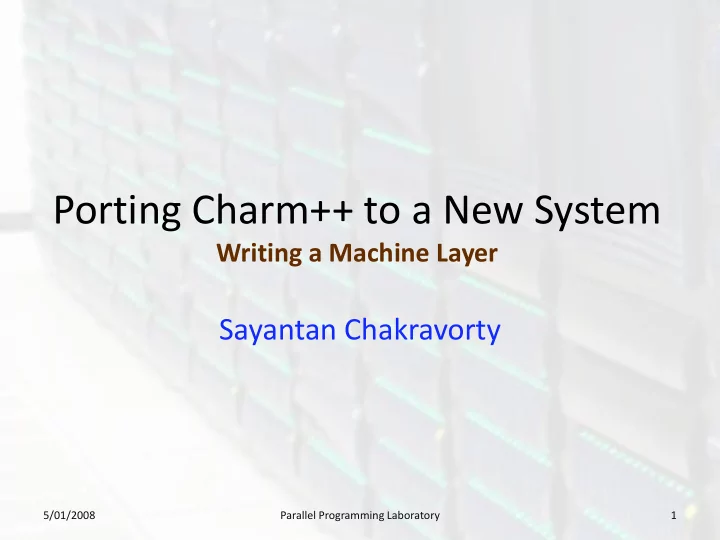

Porting Charm++ to a New System Writing a Machine Layer Sayantan Chakravorty 5/01/2008 Parallel Programming Laboratory 1
Why have a Machine Layer ? User Code .ci .C .h Charm++ Load balancing Virtualization Scheduler Converse Memory management Message delivery Machine Layer Timers 5/01/2008 Parallel Programming Laboratory 2
Where is the Machine Layer ? • Code exists in charm/src/arch/<Layer Name> • Files needed for a machine layer – machine.c : Contains C code – conv-mach.sh : Defines environment variables – conv-mach.h : Defines macros to choose version of machine.c – Can produce many variants based on the same machine.c by varying conv-mach-<option>.* • 132 versions based on only 18 machine.c files 5/01/2008 Parallel Programming Laboratory 3
What all does a Machine Layer do? ConverseInit ConverseInit ConverseInit FrontEnd CmiSyncSendFn CmiSyncSendFn CmiSyncSendFn CmiSyncBroadcastFn ConverseExit ConverseExit ConverseExit CmiAbort CmiAbort CmiAbort 5/01/2008 Parallel Programming Laboratory 4
Different kinds of Machine Layers • Differentiate by Startup method – Uses lower level library/ run time • MPI: mpirun is the frontend – cray, sol, bluegenep • VMI: vmirun is the frontend – amd64, ia64 • ELAN: prun is the frontend – axp, ia64 – Charm run time does startup • Network based (net) : charmrun is the frontend – amd64, ia64,ppc – Infiniband, Ethernet, Myrinet 5/01/2008 Parallel Programming Laboratory 5
Net Layer: Why ? • Why do we need a startup in Charm RTS ? – Using a low level interconnect API, no startup provided • Why use low level API ? – Faster » Why faster • Lower overheads • We can design for a message driven system – More flexible » Why more flexible ? • Can implement functionality with exact semantics needed 5/01/2008 Parallel Programming Laboratory 6
Net Layer: What ? • Code base for implementing a machine layer on low level interconnect API CmiMachineInit ConverseInit node_addresses_obtain CommunicationServer CmiSyncSendFn charmrun req_client_connect DeliverViaNetwork CmiSyncBroadcastFn ConverseExit CmiMachineExit CmiAbort 5/01/2008 Parallel Programming Laboratory 7
Net Layer: Startup charmrun.c machine.c main(){ ConverseInit(){ // read node file //Open socket with charmrun nodetab_init(); skt_connect(..); //fire off compute node processes //Initialize the interconnect start_nodes_rsh(); CmiMachineInit(); //Wait for all nodes to reply //Send my node data //Send nodes their node table //Get the node table Node data req_client_connect(); node_addresses_obtain(..); Node Table //Poll for requests //Start the Charm++ user code while (1) req_poll(); ConverseRunPE(); } } 5/01/2008 Parallel Programming Laboratory 8
Net Layer: Sending messages CmiSyncSendFn(int proc,int size,char *msg){ //common function for send CmiGeneralSend( proc,size,`S’,msg ); } CmiGeneralSend(int proc,int size, int freemode, char *data){ OutgoingMsg ogm = PrepareOutgoing(cs,pe, size,freemode,data); DeliverOutgoingMessage(ogm); //Check for incoming messages and completed //sends CommunicationServer(); } DeliverOutgoingMessage(OutgoingMsg ogm){ //Send the message on the interconnect DeliverViaNetwork(ogm,..); } 5/01/2008 Parallel Programming Laboratory 9
Net Layer: Exit ConverseExit(){ //Shutdown the interconnect cleanly CmiMachineExit(); //Shutdown Converse ConverseCommonExit(); //Inform charmrun this process is done ctrl_sendone_locking("ending",NULL,0, NULL,0); } 5/01/2008 Parallel Programming Laboratory 10
Net Layer: Receiving Messages • No mention of receiving messages • Result of message driven paradigm – No explicit Receive calls • Receive starts in CommunicationServer – Interconnect specific code collects received message – Calls CmiPushPE to handover message 5/01/2008 Parallel Programming Laboratory 11
Let’s write a Net based Machine Layer 5/01/2008 Parallel Programming Laboratory 12
A Simple Interconnect • Let’s make up an interconnect – Simple • Each node has a port • Other Nodes send it messages on that port • A node reads its port for incoming messages • Messages are received atomically – Reliable – Does Flow control itself 5/01/2008 Parallel Programming Laboratory 13
The Simple Interconnect AMPI • Initialization – void si_init() – int si_open() – NodeID si_getid() • Send a message – int si_write(NodeID node, int port, int size, char *msg) • Receive a message – int si_read(int port, int size, char *buf) • Exit – int si_close(int port) – void si_done() 5/01/2008 Parallel Programming Laboratory 14
Let’s start • Net layer based implementation for SI conv-mach-si.sh conv-mach-si.h #undef CMK_USE_SI #define CMK_USE_SI 1 //Polling based net layer CMK_INCDIR=“ -I/opt/si/include ” #undef CMK_NETPOLL CMK_LIBDIR=“ -I/opt/si/lib ” #define CMK_NETPOLL 1 CMK_LIB=“ $CMK_LIBS – lsi ” 5/01/2008 Parallel Programming Laboratory 15
Net based SI Layer machine-si.c machine-dgram.c #include “ si.h ” machine.c CmiMachineInit #if CMK_USE_GM //Message delivery #include "machine-gm.c “ #include “ machine-dgram.c ” #elif CMK_USE_SI DeliverViaNetwork #include “ machine-si.c ” #elif … CommunicationServer CmiMachineExit 5/01/2008 Parallel Programming Laboratory 16
Initialization machine-si.c NodeID si_nodeID; int si_port; machine.c charmrun.c static OtherNode nodes; CmiMachineInit(){ void req_client_connect(){ void node_adress_obtain(){ si_init(); si_port = si_open(); //collect all node data ChSingleNodeinfo me; si_nodeID = si_getid(); for(i=0;i<nClients;i++){ } ChMessage_recv(req_clients[i],&msg); #ifdef CMK_USE_SI ChSingleNodeInfo *m=msg->data; me.info.nodeID = si_nodeID; #ifdef CMK_USE_SI me.info.port = si_port; nodetab[m.PE].nodeID = m.info.nodeID #endif nodetab[m.PE].port = m.info.port //send node data to chamrun #endif ctrl_sendone_nolock("initnode",&me, } sizeof(me),NULL,0); //send node data to all //receive and store node table for(i=0;i<nClients;i++){ ChMessage_recv(charmrun_fd, &tab); //send nodetab on req_clients[i] for(i=0;i<Cmi_num_nodes;i++){ } nodes[i].nodeID = tab->data[i].nodeID; nodes[i].port = tab->data[i].port; } 5/01/2008 Parallel Programming Laboratory 17
Messaging: Design • Small header with every message – contains the size of the message – Source NodeID (not strictly necessary) • Read the header – Allocate a buffer for incoming message – Read message into buffer – Send it up to Converse 5/01/2008 Parallel Programming Laboratory 18
Messaging: Code machine-si.c typedef struct{ unsigned int size; machine-si.c NodeID nodeID; void CommunicationServer(){ } si_header; si_header hdr; while(si_read(si_port,sizeof(hdr),&hdr)!= 0) void DeliverViaNetwork(OutgoingMsg { ogm, int dest ,…) { void *buf = CmiAlloc(hdr.size); DgramHeaderMake(ogm- >data,…); int readSize,readTotal=0; while(readTotal < hdr.siez){ si_header hdr; if((readSize= si_read(si_port,hdr.size,buf) hdr.nodeID = si_nodeID; ) <0){} hdr.size = ogm->size; readTotal += readSize; } OtherNode n = nodes[dest]; //handover to Converse if(!si_write(n.nodeID, n.port,sizeof(hdr), } &hdr) ){} } if(!si_write(n.nodeID, n.port, hdr.size, ogm->data) ){} } 5/01/2008 Parallel Programming Laboratory 19
Exit machine-si.c NodeID si_nodeID; int si_port; CmiMachineExit (){ si_close(si_port); si_done(); } 5/01/2008 Parallel Programming Laboratory 20
More complex Layers • Receive buffers need to be posted – Packetization • Unreliable interconnect – Error and Drop detection – Packetization – Retransmission • Interconnect requires memory to be registered – CmiAlloc implementation 5/01/2008 Parallel Programming Laboratory 21
Thank You 5/01/2008 Parallel Programming Laboratory 22
Recommend
More recommend